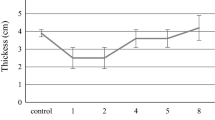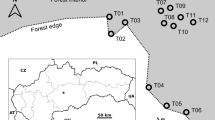Abstract
Measurements in The Netherlands show that in the winter (Dec.–March) solar radiation measured perpendicular to the solar beam can be quite strong. Consequently, high surface temperatures can occur on suitably exposed, dark surfaces of low thermal conductivity. In December, the surface temperature on the bark of old pine trees was found to be up to 28°C above the ambient air temperature. In February, the excess temperatures of pine bark reached as high as 37°C. The temperatures of steeply south-exposed pine litter were even somewhat higher. South-exposed edges of pinewoods and similar situations are especially favourable due to the wind shelter and extra radiation gain they provide. In February, ants were found to bask in clusters attaining temperatures of as much as 20°C above that of ambient air. Basking vipers attained excess temperatures of 25°C.
Similar content being viewed by others
References
ARNOLD, S. M. and J. L. MONTEITH (1974). Plant development and mean temperature in a Teesdale habitat. J. Ecol., 62: 711–720.
CORBET, P. S. (1972). The microclimate of arctic plants and animals, on land and in fresh water. Acta Arctica, Fasc. 18: 1–43.
DAWSON, W. R. (1975). On the physiological significance of the preferred body temperature of reptiles. In: Perspectives of biophysical ecology. D. M. Gates and R. B. Schmeil (ed.) Springer-Verlag, Berlin-Heidelberg-New York, 443–473.
K.N.M.I. (1972). Klimaatatlas van Nederland. Staatsuitgeverij, Den Haag.
KNEITZ, G. (1964). Untersuchungen zum Aufbau und zur Erhaltung des Nestwärmehaushaltes beiFormica polyctena Foerst. Inaug. Dissertation Universität Würzburg.
KNEITZ, G. (1970). Saisonale Veränderungen des Nestwärmehaushaltes bei Waldameisen in Abhängigkeit von der Konstitution und dem Verhalten der Arbeiterinnen als Beispiel vorteilhafter Anpassung eines Insektenstaates an das Jahreszeitenklima. Verhandlungsbericht der Deutchen Zoologischen Gesellschaft, 64. Tagung. Zool. Anz. Suppl. 33: 318–322.
MAHRINGER, W. (1961). Über die Oberflächen-temperatur eines Baumstammes in verschiedenen Jahreszeiten. Wetter u. Leben, 13: 159–165.
RICHARDS, A. G. (1957). Cumulative effects of optimum and suboptimum temperatures on insect development. In: Influence of temperature on biological systems. F. H. Johnson (ed.). Ronald Press Comp., New York, 145–162.
SAINT GIRONS, H. (1975). Observations préliminaires sur la thermorégulation des Vipères d'Europe. Vie et Milieu, Série C, 25: 137–168.
SCHOLANDER, P. F., W. FLAGG, V. WALTERS and L. IRVING (1953). Climatic adaptation in arctic and tropical poikilotherms. Physiol. Zool., 26: 67–92.
SCHMEIDL, H. (1965). Oberflächentemperaturen in Hochmooren. Wetter u. Leben, 17: 87–97.
SCHULZE, R. (1970). Strahlenklima der Erde. Steinkopff Verlag, Darmstadt.
STOUTJESDIJK, Ph. (1974). An improved simple radiation thermometer. Acta Bot. Neerl., 23: 131–136.
STOUTJESDIJK, Ph. (1974a). The open shade, an interesting microclimate. Acta Bot. Neerl., 23: 125–130.
VIITANEN, P. (1967). Hibernation and seasonal movements of the viper, Vipera berus berus (L) in southern Finland Ann. Zool. Fenn., 4: 472–546.
WIESER, W. (1973). Temperature relations of ectotherms: A speculative review. In: Effects of Temperature on Ectothermic Organisms. W. Wieser (ed.). Springer-Verlag. Berlin-Heidelberg-New York, 1–23.
Author information
Authors and Affiliations
Rights and permissions
About this article
Cite this article
Stoutjesdijk, P. High surface temperatures of trees and pine litter in the winter and their biological importance. Int J Biometeorol 21, 325–331 (1977). https://doi.org/10.1007/BF01555192
Received:
Issue Date:
DOI: https://doi.org/10.1007/BF01555192




